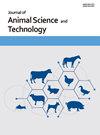Effects of paraformic acid supplementation, as an antibiotic replacement, on growth performance, intestinal morphology and gut microbiota of nursery pigs
IF 3.2
3区 农林科学
Q1 AGRICULTURE, DAIRY & ANIMAL SCIENCE
引用次数: 0
Abstract
49 A total of 150 crossbred male pigs [21±1 days old; 8.85±0.15 Kg body weight (BW)] were randomly assigned to five 50 dietary treatments with five replicates per treatment and six pigs per pen to evaluate the effect of paraformic acid 51 (PFA), as a substitute to antibiotics, on growth performance, intestinal morphology, and gut microbiota of nursery 52 pigs. The treatments were: 1) NC: nutrient adequate control diet; 2) PFA1: similar to NC plus 0.30% PFA; 3) PFA2: 53 similar to NC plus 0.60% PFA; 4) PFA3: similar to NC plus 1.0% PFA; and 5) PC: similar to NC plus 0.15% of 54 chlortetracycline. Pigs were fed the same nutritional profile during the two-phase feeding regime [phase 1 (P1; d 0– 55 14), and phase 2 (P2; d 15–30)]. Initial BW, and BW and feed disappearance at the end of each phase were recorded 56 to calculate average daily feed intake (ADFI), average daily gain (ADG), and feed to gain ratio (F: G). The Fecal score 57 was determined at the end of P1, while the intestinal morphology and microbiota analysis were performed at the end 58 of P2. Pigs fed PFA2 had higher ADG than those fed NC in P1. A quadratic response was found in the overall phase 59 1 and phase 2 (P1&2) with the highest ADG in pigs fed PFA2 ( p < 0.05). Pigs fed PC had the highest ADFI during 60 P2 and overall P1&2 ( p < 0.05). The PFA2 group had the lowest F:G ratio among treatments in P1 and P2, with a 61 quadratic response in the overall P1&2 ( p < 0.05). Pigs fed PFA1, PFA2, PFA3, and PC showed better fecal 62 consistency than NC ( p < 0.05). No differences were found in intestinal morphology among treatments. PFA groups 63 supplementation modulated the relative abundance of Lactobacillus and Streptococcus in the jejunum. In the cecum, 64 PFA2 had a higher relative abundance of Prevotella when compared to NC, but lower than PC. In addition, pigs fed 65 the NC diet had higher abundance of Treponema and Methanobrevibacter than other treatments. In conclusion, the 66 supplementation of 0.6% PFA improved growth performance and modulated gut microbiota in nursery pigs. 67添加对苯二甲酸作为抗生素替代品对苗猪生长性能、肠道形态和肠道微生物群的影响
本文章由计算机程序翻译,如有差异,请以英文原文为准。
求助全文
约1分钟内获得全文
求助全文
来源期刊

Journal of Animal Science and Technology
Agricultural and Biological Sciences-Food Science
CiteScore
4.50
自引率
8.70%
发文量
96
审稿时长
7 weeks
期刊介绍:
Journal of Animal Science and Technology (J. Anim. Sci. Technol. or JAST) is a peer-reviewed, open access journal publishing original research, review articles and notes in all fields of animal science.
Topics covered by the journal include: genetics and breeding, physiology, nutrition of monogastric animals, nutrition of ruminants, animal products (milk, meat, eggs and their by-products) and their processing, grasslands and roughages, livestock environment, animal biotechnology, animal behavior and welfare.
Articles generally report research involving beef cattle, dairy cattle, pigs, companion animals, goats, horses, and sheep. However, studies involving other farm animals, aquatic and wildlife species, and laboratory animal species that address fundamental questions related to livestock and companion animal biology will also be considered for publication.
The Journal of Animal Science and Technology (J. Anim. Technol. or JAST) has been the official journal of The Korean Society of Animal Science and Technology (KSAST) since 2000, formerly known as The Korean Journal of Animal Sciences (launched in 1956).
 求助内容:
求助内容: 应助结果提醒方式:
应助结果提醒方式:


